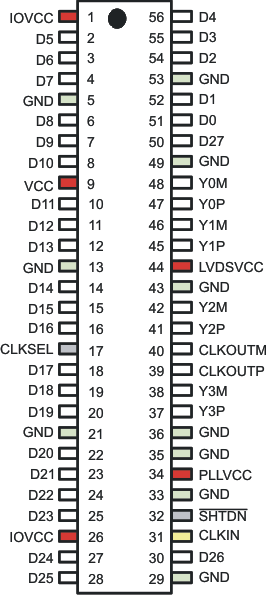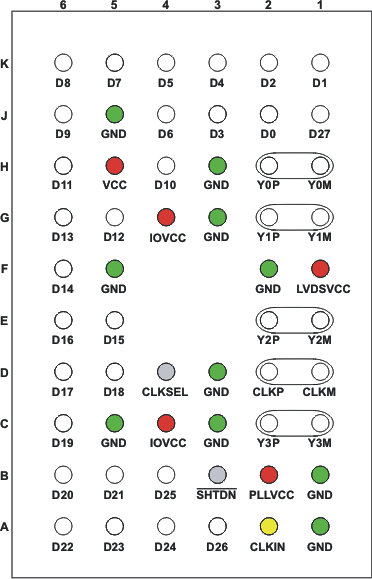SLLS992B August 2009 – March 2015 SN65LVDS93A
PRODUCTION DATA.
- 1 Features
- 2 Applications
- 3 Description
- 4 Revision History
- 5 Description (continued)
- 6 Pin Configuration and Functions
- 7 Specifications
- 8 Parameter Measurement Information
- 9 Detailed Description
- 10Application and Implementation
- 11Power Supply Recommendations
- 12Layout
- 13Device and Documentation Support
- 14Mechanical, Packaging, and Orderable Information
Package Options
Mechanical Data (Package|Pins)
- DGG|56
Thermal pad, mechanical data (Package|Pins)
Orderable Information
6 Pin Configuration and Functions
DGG Package
56-Pin TSSOP
(Top View)

ZQL Package
56-Ball BGA MICROSTAR
(Top View)

Pin Functions - TSSOP
| PIN | I/O | DESCRIPTION | |
|---|---|---|---|
| NAME | NO. | ||
| CLKSEL | 17 | I | Selects between rising edge input clock trigger (CLKSEL = VIH) and falling edge input clock trigger (CLKSEL = VIL). |
| CLKIN | 31 | I | Input pixel clock; rising or falling clock polarity is selectable by Control input CLKSEL. |
| CLKOUTM | 40 | O | Differential LVDS pixel clock output. Output is high-impedance when SHTDN is pulled low (de-asserted). |
| CLKOUTP | 39 | O | |
| D0 | 51 | I | Data inputs; supports 1.8-V to 3.3-V input voltage selectable by VDD supply. To connect a graphic source successfully to a display, the bit assignment of D[27:0] is critical (and not necessarily intuitive). Note: if application only requires 18-bit color, connect unused inputs D5, D10, D11, D16, D17, D23, and D27 to GND |
| D1 | 52 | ||
| D2 | 54 | ||
| D3 | 55 | ||
| D4 | 56 | ||
| D5 | 2 | ||
| D6 | 3 | ||
| D7 | 4 | ||
| D8 | 6 | ||
| D9 | 7 | ||
| D10 | 8 | ||
| D11 | 10 | ||
| D12 | 11 | ||
| D13 | 12 | ||
| D14 | 14 | ||
| D15 | 15 | ||
| D16 | 16 | ||
| D17 | 18 | ||
| D18 | 19 | ||
| D19 | 20 | ||
| D20 | 22 | ||
| D21 | 23 | ||
| D22 | 24 | ||
| D23 | 25 | ||
| D24 | 27 | ||
| D25 | 28 | ||
| D26 | 30 | ||
| D27 | 50 | ||
| GND | 5, 13, 21, 29, 33, 35, 36, 43, 49, 53 | Power Supply(1) | Supply Ground for VCC, IOVCC, LVDSVCC, and PLLVCC. |
| IOVCC | 1, 26 | I/O supply reference voltage (1.8 V up to 3.3 V matching the GPU data output signal swing) | |
| LVDSVCC | 44 | 3.3-V LVDS output analog supply | |
| PLLVCC | 34 | 3.3-V PLL analog supply | |
| SHTDN | 32 | I | Device shut down; pull low (de-assert) to shut down the device (low power, resets all registers) and high (assert) for normal operation. |
| VCC | 9 | Power Supply(1) | 3.3-V digital supply voltage |
| Y0M | 48 | O | Differential LVDS data outputs. Outputs are high-impedance when SHTDN is pulled low (de-asserted) |
| Y1M | 46 | ||
| Y2M | 42 | ||
| Y0P | 47 | ||
| Y1P | 45 | ||
| Y2P | 41 | ||
| Y3M | 38 | O | Differential LVDS Data outputs. Output is high-impedance when SHTDN is pulled low (de-asserted). Note: if the application only requires 18-bit color, this output can be left open. |
| Y3P | 37 | ||
(1) For a multilayer pcb, TI recommends keeping one common GND layer underneath the device and connecting all ground terminals directly to this plane.
Pin Functions - BGA MICROSTAR
| BALL | I/O | DESCRIPTION | |
|---|---|---|---|
| NAME | NO. | ||
| CLKIN | A2 | CMOS IN with pulldn | Input pixel clock; rising or falling clock polarity is selectable by Control input CLKSEL. |
| CLKM | D1 | LVDS Out | Differential LVDS pixel clock output. Output is high-impedance when SHTDN is pulled low (de-asserted). |
| CLKP | D2 | ||
| CLKSEL | D4 | CMOS IN with pulldn | Selects between rising edge input clock trigger (CLKSEL = VIH) and falling edge input clock trigger (CLKSEL = VIL). |
| D0 | J2 | CMOS IN with pulldn | Data inputs; supports 1.8-V to 3.3-V input voltage selectable by VDD supply. To connect a graphic source successfully to a display, the bit assignment of D[27:0] is critical (and not necessarily intuitive). Note: if application only requires 18-bit color, connect unused inputs D5, D10, D11, D16, D17, D23, and D27 to GND. |
| D1 | K1 | ||
| D2 | K2 | ||
| D3 | J3 | ||
| D4 | K3 | ||
| D5 | K4 | ||
| D6 | J4 | ||
| D7 | K5 | ||
| D8 | K6 | ||
| D9 | J6 | ||
| D10 | H4 | ||
| D11 | H6 | ||
| D12 | G5 | ||
| D13 | G6 | ||
| D14 | F6 | ||
| D15 | E5 | ||
| D16 | E6 | ||
| D17 | D6 | ||
| D18 | D5 | ||
| D19 | C6 | ||
| D20 | B6 | ||
| D21 | B5 | ||
| D22 | A6 | ||
| D23 | A5 | ||
| D24 | A4 | ||
| D25 | B4 | ||
| D26 | A3 | ||
| D27 | J1 | ||
| GND | A1, B1, C3, C5, F2, F5, J5, D3, G3, H3 | Power Supply(1) | Supply Ground for VCC, IOVCC, LVDSVCC, and PLLVCC. |
| IOVCC | C4, G4 | I/O supply reference voltage (1.8 V up to 3.3 V matching the GPU data output signal swing) | |
| LVDSVCC | F1 | 3.3-V LVDS output analog supply | |
| PLLVCC | B2 | 3.3-V PLL analog supply | |
| SHTDN | B3 | CMOS IN with pulldn | Device shut down; pull low (de-assert) to shut down the device (low power, resets all registers) and high (assert) for normal operation. |
| VCC | H5 | Power Supply(1) | 3.3-V digital supply voltage |
| Y0M | H1 | LVDS Out | Differential LVDS data outputs. Outputs are high-impedance when SHTDN is pulled low (de-asserted) |
| Y1M | G1 | ||
| Y2M | E1 | ||
| Y0P | H2 | ||
| Y1P | G2 | ||
| Y2P | E2 | ||
| Y3M | C1 | LVDS Out | Differential LVDS Data outputs. Output is high-impedance when SHTDN is pulled low (de-asserted). Note: if the application only requires 18-bit color, this output can be left open. |
| Y3P | C2 | ||
| -- | E3, E4, F3, F4 | – | Not connected |
(1) For a multilayer pcb, it is recommended to keep one common GND layer underneath the device and connect all ground terminals directly to this plane.